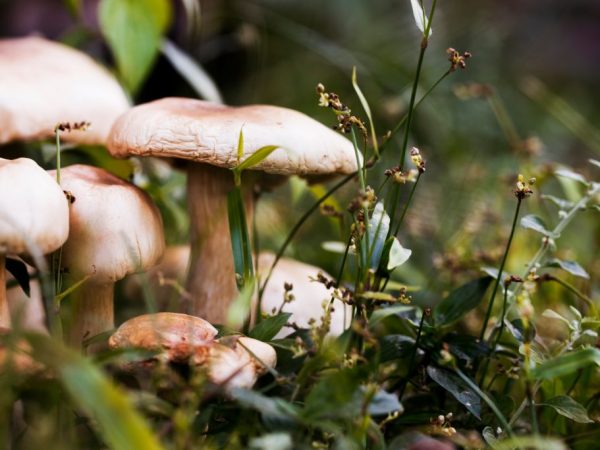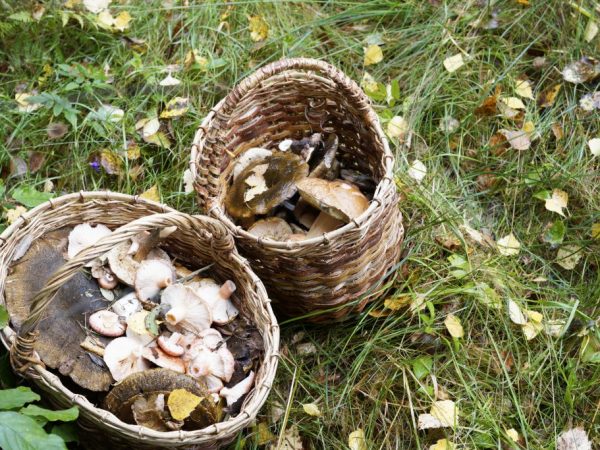Description of the mushroom thin pig
Pigs are a genus of mushrooms in the Pig family, which includes both edible and inedible members. The slender pig mushroom is a poisonous species. It is also called sow, cowshed, salty and sow. It is often found in coniferous and young deciduous forests.

Description of the mushroom thin pig
Description of the appearance of the mushroom
There are related species - the fat pig and the thin pig. The thin pig's cap reaches 10-15 cm in length, sometimes up to 20 cm. It is fleshy, slightly convex, has an edge tucked inward. In an older mushroom, the cap becomes flat, and the middle is depressed. The edge is often wavy.
Description of the mushroom thin pig:
- Young mushrooms have a light brown cap color, adults - dark brown or rusty. If you press on it or make an incision, the color darkens.
- A young slender pig has a fluffy cap surface, dry to the touch, an adult smoother. It becomes sticky after rain.
- The flesh of a young mushroom is soft, but dense, but in age mushrooms it is loose. The pulp is light yellow in color, darkens on the cut. In dry weather, worms are often found in it. There is no distinctive taste or smell.
The length of the leg reaches 10 cm, the diameter is up to 3 cm. Its surface is smooth, yellow, with an olive tint. It has the shape of a cylinder, the lower part is narrowed. Often the leg is attached to the head at the edge, not in the center.
The mushroom begins to bear fruit in May and ends in October. Sometimes it grows in vegetable gardens, parks and along roads.

The thin pig's hat reaches 10-15 cm
The difference between a thin and thick pig:
- the fat pig grows only in temperate climates;
- grows on stumps and tree trunks (pine);
- the thick one begins to bear fruit only in the middle of summer.
The venomousness of the thin pig
Thin pig is a poisonous mushroom. It contains lectins: substances that are not destroyed even with prolonged heat treatment. Copper isotopes and heavy metals also accumulate.
Previously, the thin pig was considered edible, but in 1944 the first death was recorded: the German mycologist Julius Scheffer, who ate cooked pigs, died of acute renal failure 17 days later in October 1944. Before that, he showed signs of food poisoning: vomiting, diarrhea and fever.
On the territory of the USSR, until 1981, the slender pig or, as it is also called, "pig", "filly", "pig's ear" belonged to conditionally edible mushrooms of the 4th category. Since 1984, it has been classified as a poisonous mushroom.
Irina Selyutina (Biologist):
To date, it has been established that the development of symptoms of gastrointestinal poisoning is progressing very quickly: abdominal pain, vomiting and diarrhea. Moreover, the volume of circulating blood sharply decreased (diarrhea causes dehydration of the body). Then the signs appear more severe, characteristic of the so-called. intravascular hemolysis (destruction of erythrocytes - red blood cells and release into the environment - blood plasma, hemoglobin).This can lead to both acute renal and respiratory failure and intravascular blood coagulation.
There is no antidote at this point in the study history.
In humans, the first symptoms of poisoning appear after a different period of time. This is influenced by the individual susceptibility of the organism.
The substances contained in this mushroom cause the destruction of red blood cells in the blood, which threatens diseases such as anemia or jaundice. If you do not provide medical assistance in time, the use of a large amount of these mushrooms is fatal.
Poisoning symptoms
The first symptoms may appear within 30-40 minutes after consumption. This is muscarinic syndrome. It has the following features:
- increased salivation;
- weakness;
- headache;
- decrease in pressure;
- increased sweating.
Later, an upset stomach begins and loose stools appear. When a large amount of poison enters, swelling of the brain and lung tissue begins. Immediate medical attention is needed.
Such symptoms of poisoning do not always appear. If a person eats this product rarely and in small portions, they may not be there. But toxic substances - lectins - accumulate in the body, and blood clotting accelerates.
Irina Selyutina (Biologist):
Lectins - proteins and glycoproteins (proteins that contain carbohydrates), which are able to bind carbohydrate residues on the cell surface and cause agglutination of erythrocytes. Agglutination is a process in which erythrocytes stick together (in a "lump"), which as a result precipitate from a previously homogeneous suspension.
By the way. Lectins were first discovered in plant seeds over 100 years ago, but now they are known for most living organisms.
This threatens with thrombosis, anemia, as well as heart attack, stroke and pulmonary vein thrombosis.
Treatment for poisoning
When the first symptoms of poisoning appear, they immediately call an ambulance. It is important to drink as much water or chilled strong tea as possible before the doctor arrives. This helps to flush out the stomach and detoxify the body.
It will be useful to take enterosorbents. They help to quickly remove toxic substances. Suitable "Smecta", "Enterosgel" or ordinary activated carbon (1 tablet per 10 kg of mass).
Also, the patient is given an enema or a laxative. It is important to do this so that poisons leave the body faster.

When the first symptoms of poisoning appear, they immediately call an ambulance.
When providing first aid in case of poisoning, it is strictly prohibited:
- induce vomiting in children under 2 years of age and pregnant women;
- give enemas to the elderly without the help of a physician;
- give the patient fixing medications.
After hospitalization, the victim is detoxified. The way it is carried out depends on how much dangerous product the patient ate. It can be one of the following options; gastric lavage, enema or hemodialysis.
Then the water-electrolyte balance is restored. In more severe cases, a dropper is given. The patient is later treated with antibiotics.
In order for the body to recover faster after poisoning, it is necessary to adhere to a diet. Her description:
- refusal from fatty, smoked and spicy dishes;
- a complete ban on smoking and drinking;
- the presence of boiled or steamed food on the menu;
- chopping vegetables and fruits before eating.
Conclusion
Thin pig mushroom used to be considered conditionally edible, but now it is classified as inedible. Its poisonous properties cannot be neutralized even after long cooking. It can cause allergic reactions, the consequences of which are difficult to predict. In addition, the slender pig is capable of accumulating radioactive isotopes of cesium and copper in its fruit bodies. As a result, the content of radioisotopes or heavy metal salts can be several times higher than the concentration of these substances in the soil.
The slender pig is found from late spring to October. Symptoms of poisoning may not appear immediately. Sometimes the use of the mushroom is fatal.



